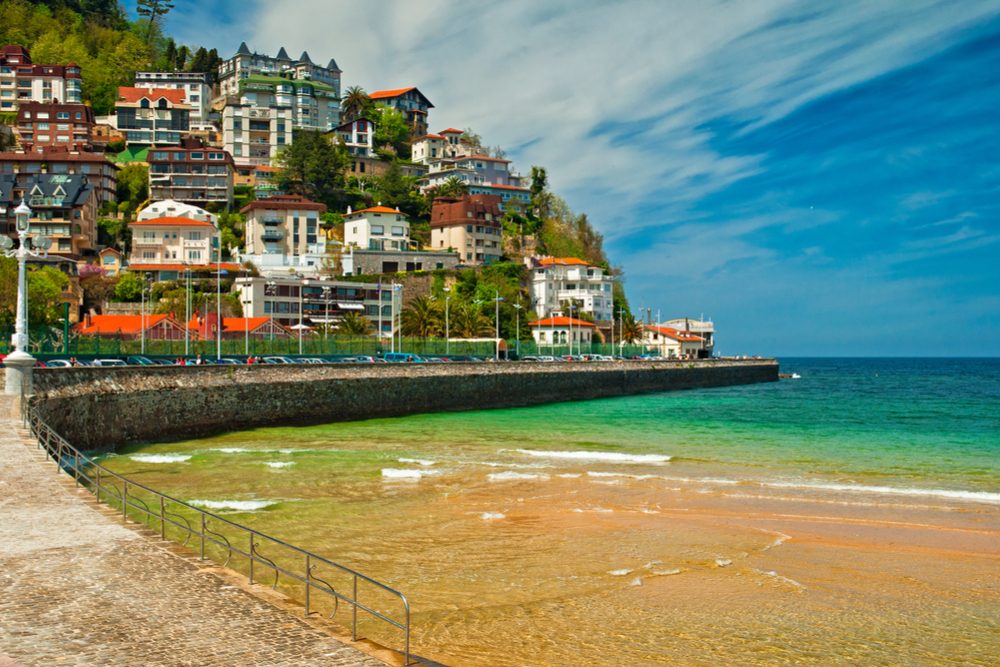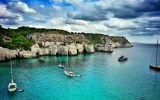A whopping 8 percent jump in international visitors in 2017 made Spain the second most visited country in the world (after France; the U.S. has been bumped to third place), and yet, much of the country remains relatively unexplored. Here, we help you zero in on the less-touristed areas that are most colorful and charming—along with the best way to experience them:
The Basque Coast

San Sebastian, Spain, is a good base for exploring the Basque Coast. Photo: Shutterstock
The flysch of the Basque Country and the cliffs overlooking the Atlantic in Galicia are coastal areas known for their natural beauty rather than large beach resorts. The seaside town of San Sebastián is a good base for exploring the Basque Coast. The city itself is walkable, and it’s known for its food scene—there are so many Michelin-star restaurants that it’s hard to have a bad meal. Many visitors stay put except for a side trip to the Guggenheim in Bilbao, but it’s a good idea to hire a guide or rent a car and explore the coast; you’ll find lots of charming seaside villages where you can stop for lunch or a hike. The 100-million-year-old rock formations along the Flysch Route can be seen at Itzurun Beach, near the Algorri Visitor Center in Zumaia.
Asturias
This province in northwest Spain is a wonderful stop for nature lovers, with a beautiful landscape, rolling mountains, hiking routes, and a scenic coastline. Highlights include Picos de Europa National Park and numerous pre-Romanesque monuments, particularly in Oviedo. There are lots of tiny rural villages and seaside towns, and the beaches are less crowded and touristy than in other parts of Spain, because they’re the beaches where people who live in the town go. The best hotels are not right on the beach but slightly inland; check out the Parador de Cangas de Onís, a former monastery in Picos de Europa National Park, and La Posada de Babel in the seaside village of Llanos.
León
León is a vibrant city with great museums, restaurants, and—somewhat unusual in a smaller city—a thriving nightlife scene, especially in the Barrio Húmedo, where you’ll find bars specializing in gin, cider, beer, and, of course, wine. One of the few tourist venues that get crowded is the Gothic cathedral, an architectural gem— León is on the Santiago de Compostela pilgrimage route. Other cultural highlights of a tour of León: Gaudí’s Casa Bontines, the Museo de Arte Contemporaneo, Museo León, and the Convento de San Marcos.
A gastronomy capital, León is known for the heavier cuisine of the north—cured meats, cheeses—and is close to some good wineries. A good day-trip is to rent a car and drive 90 minutes to an area called Toro, known for its full-bodied red wines. About 45 minutes from León is the restaurant and farm of El Capricho de Jimenez, world-famous for its ox.
A good place to stay is the Hostal de San Marcos (aka the Parador de León), a converted 16th-century stone monastery that is one of most beautiful historic hotels in Europe.
Menorca
For a dip in the Mediterranean, head to Menorca, the least crowded of the Balearic Islands, and the most relaxed. As a result it’s great for families—or anyone who prefers to avoid the beach parties and all-night discos found on Menorca’s sister islands Ibiza and Mallorca. Many of the most charming hotels are slightly inland—although not right on the sea, they have a pool. Two good choices are the whitewashed converted farm buildings of Torralbenc, a luxury property with a spa and pretty views, and Alcaufar Vell, a stone farmhouse that dates to the fourteenth century.
Many of the most charming hotels are slightly inland—although not right on the sea, they have a pool. Two good choices are the whitewashed converted farm buildings of Torralbenc, a luxury property with a spa and pretty views, and Alcaufar Vell, a stone farmhouse that dates to the fourteenth century.
To ensure that you experience some of the local culture beyond your resort, rent a car or hire a guide and see what the island’s small towns and small beaches have to offer. Two beaches beloved by locals are Macarela and Mitjana.
Tips for Negotiating Packed Venues
• Don’t sleep in. In Spain, things tend to run later, so you’ll avoid the crowds if you start your day early.
• Don’t wait in line to buy a ticket. Either hire an expert guide or purchase your tickets in advance, for a time slot at the beginning of the day.
• Take a tip from the Spanish playbook and eat a late dinner, when it’s much cooler. Or take advantage of the late hours and get up early and enjoy watching as the town or city around you comes to life.
• Many museums, like the Alhambra in Granada and La Pedrera in Barcelona, have nighttime visiting hours. It’s a way to visit when it’s less crowded, and not as hot.
• It’s worth hiring a guide for the big museums, like the Alhambra and La Pedrera. The guides know what’s important and what’s worth skipping, and they can get you past a big crowd because they know the museum staff.
• The last few hours of the day are free entry at the Museo Reina Sofía and the Prado in Madrid, and those are terrible times to go. You’ll see lines forming hours before they start letting people in.
• Once inside the museum, you’ll be happier with a human guide than an audioguide, which will send you on the same crowded path with everyone else wearing headphones. So either study up on the museums before you enter, or hire a guide to show you the most interesting spots using a different route than the ones most people will be taking.
Be a smarter traveler: Read real travelers’ reviews of Wendy’s WOW List and use it to plan your next trip. You can also follow her on Facebook, Twitter @wendyperrin, and Instagram @wendyperrin, and sign up for her weekly newsletter to stay in the know.






